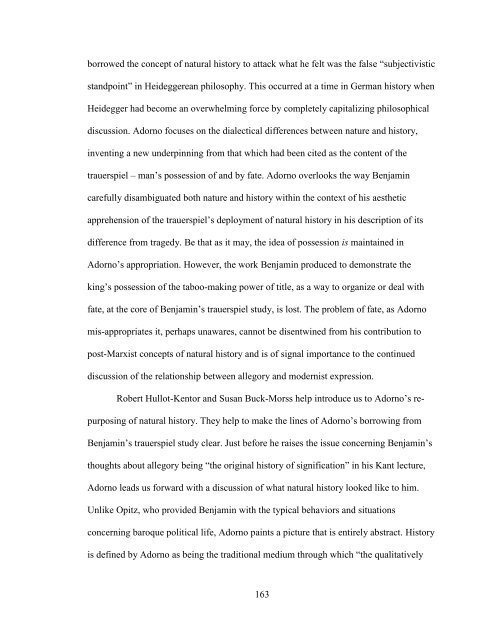TABOO: THE ACTUAL MODERNIST AESTHETIC, MADE REAL A ...
TABOO: THE ACTUAL MODERNIST AESTHETIC, MADE REAL A ...
TABOO: THE ACTUAL MODERNIST AESTHETIC, MADE REAL A ...
Create successful ePaper yourself
Turn your PDF publications into a flip-book with our unique Google optimized e-Paper software.
orrowed the concept of natural history to attack what he felt was the false ―subjectivistic<br />
standpoint‖ in Heideggerean philosophy. This occurred at a time in German history when<br />
Heidegger had become an overwhelming force by completely capitalizing philosophical<br />
discussion. Adorno focuses on the dialectical differences between nature and history,<br />
inventing a new underpinning from that which had been cited as the content of the<br />
trauerspiel – man‘s possession of and by fate. Adorno overlooks the way Benjamin<br />
carefully disambiguated both nature and history within the context of his aesthetic<br />
apprehension of the trauerspiel‘s deployment of natural history in his description of its<br />
difference from tragedy. Be that as it may, the idea of possession is maintained in<br />
Adorno‘s appropriation. However, the work Benjamin produced to demonstrate the<br />
king‘s possession of the taboo-making power of title, as a way to organize or deal with<br />
fate, at the core of Benjamin‘s trauerspiel study, is lost. The problem of fate, as Adorno<br />
mis-appropriates it, perhaps unawares, cannot be disentwined from his contribution to<br />
post-Marxist concepts of natural history and is of signal importance to the continued<br />
discussion of the relationship between allegory and modernist expression.<br />
Robert Hullot-Kentor and Susan Buck-Morss help introduce us to Adorno‘s re-<br />
purposing of natural history. They help to make the lines of Adorno‘s borrowing from<br />
Benjamin‘s trauerspiel study clear. Just before he raises the issue concerning Benjamin‘s<br />
thoughts about allegory being ―the original history of signification‖ in his Kant lecture,<br />
Adorno leads us forward with a discussion of what natural history looked like to him.<br />
Unlike Opitz, who provided Benjamin with the typical behaviors and situations<br />
concerning baroque political life, Adorno paints a picture that is entirely abstract. History<br />
is defined by Adorno as being the traditional medium through which ―the qualitatively<br />
163
















